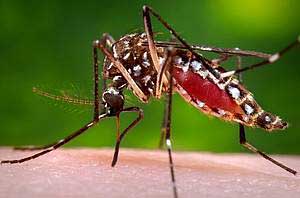June 1, 2017
Mosquitoes infected with virus-suppressing bacteria could help control dengue fever
Strategic releases could transform mosquito populations and virus transmission across cities – IST Austria scientist involved in study published in PLOS Biology

Mosquitos infected with the bacteria Wolbachia are significantly worse vectors for dengue virus, and are therefore a promising tool in fighting the disease, but how to establish and spread Wolbachia in an urban mosquito population is unclear. A study publishing on 30th May 2017 in the open access journal PLOS Biology by Michael Turelli from University of California, Davis in collaboration with Nick Barton from the Institute of Science and Technology (IST Austria) and colleagues from Scott O’Neill’s “Eliminate Dengue Program” demonstrates that over time, strategic releases may allow mosquitoes infected with the dengue-suppressing bacteria to spread across large cities.
More than 2.5 billion people live in areas afflicted by dengue fever, a mosquito-borne viral disease that is increasing at alarming rates in tropical and subtropical countries. Suppression efforts have mainly focused on mosquito control, but an international, non-profit research collaboration, the Eliminate Dengue Program, is trialing a new approach: harnessing bacteria that infect mosquitoes and so reduce their capacity to transmit viruses. The researchers released adult Aedes aegypti mosquitoes infected with Wolbachia bacteria in three areas near to suitable mosquito habitat in Cairns, Queensland. Two of the sites were relatively large (about 1 square kilometer and half a square kilometer, respectively), while the third was smaller (about a tenth of a square kilometer), and received more than 130,000; 286,000; and 35,000 Wolbachia-infected mosquitoes, respectively. The researchers tracked the spread of Wolbachia through mosquito populations over two years by trapping and testing them for the bacteria.
The researchers found that Wolbachia-infected mosquitoes spread at about 100-200 meters per year in the larger sites, but there was little evidence of such spread in the smaller area even after two years. This suggests that as long as the introduction sites are large enough, strategic releases can transform urban mosquito populations. While slow, the spread in the larger sites was generally steady. However, the researchers also found that spread could be impeded by barriers to mosquito movement, which could include roads, rivers and forests. This suggests that local barriers to mosquito dispersal should be taken into account when determining how many releases of Wolbachia-infected mosquitoes are required.
“Mathematical methods that were first developed to understand hybridisation in nature have turned out to be useful in designing biocontrol programs,” explains Nick Barton from IST Austria. “Working with Michael Turelli from the University of California, I have shown how simple models can be accurate, despite a variety of biological complications. Thus, one can estimate key parameters, such as the rate of dispersal and the threshold frequency needed to establish the infection, simply by observing how the infection frequency changes over time. This helps us to design the best strategy for transforming mosquito populations, so that dengue can no longer spread.”
Publication
Schmidt TL, Barton NH, Rasic G, Turley AP, Montgomery BL, Iturbe-Ormaetxe I, et al. (2017): Local introduction and heterogeneous spatial spread of dengue-suppressing Wolbachia through an urban population of Aedes aegypti. PLoS Biol 15(5): e2001894. https://doi.org/10.1371/journal.pbio.2001894



